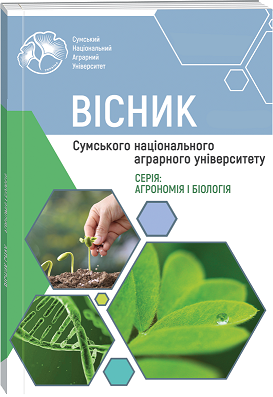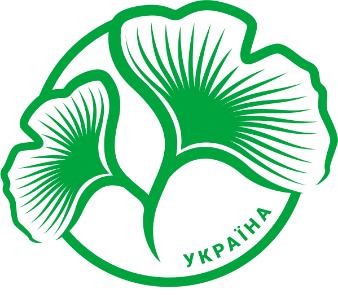Biodiversity of the proposed reserve “Pshinchyne”
Abstract
According to the results of a study of the valley of the river Khmelivka near the Basivka and Pshinchyne villages, Romny district, Sumy region the biodiversity was firstly characterized and the creation of the reserve with the local value named «Pshinchyne» was offered.
Flora, vegetation and fauna of the territory were studied with the usage of recognized floristical, geobotanical, zoological methods, reconnaissance and route-detailed in particular. We investigated that the dominating part of this valley territory is covered by the air-watered vegetation represented by the mono-groups of Phragmites australis (Cav.) Trin. ex Steud.). Peat meadows are spread with the domination of Deshampsia caespitosa (L.) P. Beauv.). Meadow-steppe groups dominate on the two barrows with the major abundance of Elytrigia repens (L.) Nevski, Festuca valesiaca Gaudin, Festuca pratensis Huds., Poa pratensis L., Carex hirta L. We marked that within the river valley the trees Alnus glutinosa L. (Gaerth.), Salix fragilis L., Populus tremula L., Salix triandra L., Salix pentandra L. are actively spread.
The analisys of the fauna of the territory showed that at the riverbed part Rana ridibund and Rana arvalis are spread. Natrix natrix occurred at the coastal part. At the land part it was pointed the representatives of Capreolus capreolus, Lepus europaeus, Vulpes vulpes.
The sozological value of the proposed reserve «Pshinchyne» consists of the 2 flora species declared in the Red book of Ukraine ‒ Dactylorhiza incarnata (L.) Soó. і Dactylorhyza fuchsii (Druce) Soо. and 23 plant species represented in the Red list of IUCN with the LC range of protection. Among the fauna there are 27 species with the IUCN protection status with the LC range, among them – 19 belong to the lists of annexes II and III of Bern convention. The results of conducted geographic-aesthetical and psycho-aesthetical rating bear evidence to high aesthetical value of the landscape of the river valley Khmelivka near Basivka and Pshinchyne villages and confirmed the expediency of this territory to be included to the nature reserve fund of Sumy region.
References
2. Dupuy P., & Viñuales, J. (2018). International Environmental Law (2nd ed.). Cambridge: Cambridge University Press. doi: 10.1017/9781108399821
3. Rabosky, D.L., (2009). Ecological limits and diversification rate: alternative paradigms to explain the variation in spe-cies richness among clades and regions. Ecology Letters, 12 (8), 735–743. doi: 10.1111/j.1461-0248.2009.01333.x
4. Dornelas, M. (2010). Disturbance and change in biodiversity Phil. Trans. R. Soc. B365, 3719–3727. doi: 10.1098/rstb.2010.0295
5. Brink, B. I. E. (2007). Biodiversity Indicators for the OECD Environmental Outlook and Strategy: a feasibility study. RIVN report, Bilthoven, The Netherlands. doi: 10.1787/eco_outlook-v2007-1-25-en
6. Salk, C. F., Chazdon, R., & Waiswa, R. (2020). Thinking outside the plot: monitoring forest biodiversity for social-ecological research. Ecology and Society, 25(1), 7. doi: 10.5751/ES-11223-250107
7. Magda, D., Plantureux, S., Agreil, C., Amiaud, B., Mestelan, P., & Mihout, S. (2015). Integrating Agricultural and Eco-logical Goals into the Management of Species-Rich Grasslands: Learning from the Flowering Meadows Competition in France. Environmental Management, 56(5), 1053–1064. doi: 10.1007/s00267-015-0553-6.
8. Sizykh, A. P. (2016). Determination of the Degree of Pasture Factor Digression in the Communities of Environment Contact Sites (Some Methodological Approaches). Open Access Library Journal, 3(9), 1–4. doi: 10.4236/oalib.1103025
9. Danielsen, F., Burgess, N. D., Balmford, A., Donald, P. F., Funder, M., Jones, J. P. G., Alviola, P., Balete, D. S., Blomley, T., Brashares, J., Child, B., Enghoff, M., Fjeldså, J., Holt, S., Hübertz, H., Jensen, A. E., Jensen, P. M., Massao, J., Mendoza, M. M., Ngaga, Y., Poulsen, M. K., Rueda, R., Sam, M., Skielboe, T., Stuart-Hill, G., Topp-Jørgensen, E., & Yonten, D. (2009). Local participation in natural resource monitoring: a characterization of approaches. Conservation Biology, 23(1), 31‒42. doi: 10.1111/j.1523-1739.2008.01063.x
10. Alons, G. (2017). Environmental policy integration in the EU's common agricultural policy: greening or greenwash-ing? J. Eur. Publ. Pol. 24, 1604–1622. doi: 10.1080/13501763.2017.1334085
11. Naeem, S., Chazdon, R., Duffy, J. E., Prager, C., & Worm, B. (2016). Biodiversity and human well-being: an essen-tial link for sustainable development. Proceedings of the Royal Society, 283(1844), 26‒43. doi: 0.1098/rspb.2016.2091
12. Cardinale, B. J., Duffy, J. E., Gonzalez, A., Hooper, D. U., Perrings, C., Venail, P., Narwani, A., Mace, G. M., Tilman, D., Wardle, D. A., Kinzig, A. P., Daily, G. C., Loreau, M., Grace, J. B., Larigauderie, A., Srivastava, D. S., & Naeem, S. (2012). Biodiversity loss and its impact on humanity. Nature, 486, 59–67. doi: 10.1038/nature11148
13. Díaz, S., Fargione, J., Chapin, III F. S., & Tilman, D. (2006). Biodiversity loss threatens human well-being. Plos Biol-ogy 4(8), 277. doi: 10.1371/journal.pbio.0040277
14. James, A.N. (2007). Financial indicators and targets for protected areas. In Background paper for GBF6: Dialogue on Biodiversity Indicators and Targets. doi: 10.1641/0006-3568(2001)051[0043:CWATCB]2.0.CO;2
15. Mace, G. M., Norris, K., & Fitter, A. H. (2012). Biodiversity and ecosystem services: a multilayered relationship. Trends in Ecology and Evolution, 27(1), 19‒26. doi: 10.1016/j.tree.2011.08.006
16. Marselle, M., Hartig, T., Cox, D., de Bell, S., Knapp, S., Lindley, S., & Bonn, A. (2020). Pathways linking biodiversity to human health: A conceptual framework. doi: 10.32942/osf.io/czyv4
17. Movchan, Ja. I. (2000). Zberezhennja biorozmai'ttja Ukrai'ny (kontekst ekopolityky) [Conservation of the biodiversity of Ukraine (ecopolitics context)], 18, II, Naukovi zapysky NaUKMA, Kyiv (in Ukrainian).
18. Justus, J., Colyvan, M., Regan, H., & Maguire, L. (2009). Buying into conservation: intrinsic versus instrumental val-ue. Trends in Ecology and Evolution 24(4), 187‒191. doi: 10.1016/j.tree.2008.11.011
19. Sheljag-Sosonko, Ju. R., Dubyna, D. V., Vakarenko, L. P., & Movchan, Ja. I. (2003). Zberezhennja i nevysnazhlyve vykorystannja bioriznomanittja Ukrai'ny: stan ta perspektyvy: vyp. 2. Zberezhennja ta vykorystannja [Conservation and inex-haustible using of the biodiversity of Ukraine: current state and perspective]. "Himdzhest", Kyiv (in Ukrainian).
20. Grodzyns'kyj, D. M. (2007) Problemy zberezhennja ta vidnovlennja bioriznomanittja v Ukrai'ni [Problems of conser-vation and restoration of the biodiversity in Ukraine]. Vyd. dim "Akademperiodyka", Kyiv (in Ukrainian).
21. Akimov, I. A., Balashov, L. S., Bjeljakov, O. O., & Solomaha, V. A. (2003). Zberezhennja bioriznomanittja Ukrai'ny (druga nacional'na dopovid') [Conservation of the biodiversity of Ukraine ( the 2nd national report]. "Himdzhest", Kyiv (in Ukrain-ian).
22. Derzhavna stratehiya rehional’noho rozvytku na period do 2020 roku, zatverdzhena postanovoyu Kabinetu Ministriv Ukrayiny vid 6 serpnya 2014 r. No 385 [State strategy for regional development for the period up to 2020, approved by the resolution of the Cabinet of Ministers of Ukraine of August 6, 2014 No 385]. [Electronic resource]. Access mode: http://zakon5.rada.gov.ua/laws/show/385-2014-%D0%BF(in Ukrainian).
23. Pryrodno-zapovidnyy fond Sums’koyi oblasti (2016). Nature reserve fund of Sumy region]. Atlas-dovidnyk. TOV «Ukrayins’ka Kartohrafichna Hrupa»,Kyiv. (in Ukrainian).
24. Sklyar, V. H., & Sklyar, Yu. L. (2014). Stvorennya novykh terytoriy pryrodno-zapovidnoho fondu yak vazhlyvyy skladnyk rozbudovy strukturnykh elementiv ekomerezhi Polis’koyi chastyny Sums’koyi oblasti [Creation of new territories of the nature reserve fund as an important component of the development of structural elements of anecological network of the Polissia part of Sumy region]. Naukovyy visnyk Skhidnoyevropeys’koho Natsional’noho universytetu im. Lesi Ukrayinky. Seriya «Biolohichni nauky», 13(290),61‒66 (in Ukrainian).
25. Sklyar, M. Yu., & Sklyar, Yu. L. (2016). Ukriplennya strukturnykh elementiv ekomerezhi skhidnoyi chastyny Novhorod-Sivers’koho Polissya za rakhunok stvorennya novykh pryrodno-zapovidnykh ob’yektiv [Strengthening the structural elements of the eco-network of the eastern part of the Novgorod-Seversky Polissya by creating new nature-protected objects]. Visnyk Cherkas’koho universytetu. Seriya: Biolohichni nauky, 1,90–97 (in Ukrainian).
26. Sklyar, V. H., & Sklyar, Yu. L. (2003). Systemnyy pidkhid do optymizatsiyi okhorony pryrodnykh kom-pleksiv[Integrated approach to optimization of protection of natural complexes].Ukrai'ns'kyj botanichnyj zhurnal, 60(4), 388‒396 (in Ukrainian).
27. Geografichna encyklopedija Ukrai'ny: [u 3 t.] T. 3. [Geographical encyclopedia of Ukraine. T. 3]. (1998). «Ukrai'ns'ka Radjans'ka Encyklopedija» im. M. P. Bazhana, Kyiv (in Ukrainian).
28. Sheyko, V. M., & Kushnarenko, N. M. (2003). Orhanizatsiya ta metodyka naukovo-doslidnyts’koyi diyal’nosti [Organ-ization and methodology of research activities]. Znannya–Pres, Kiev (in Ukrainian).
29. Polevaya geobotanika. (1959). [Field geobotany]. Izdatel'stvo Akademii Nauk SSSR, Moskva, 1 (in Russian).
30. Polevaya geobotanika. (1964). [Field geobotany]. Nauka, Moskva-Leningrad, 3 (in Russian)
31. Grishhenko, V. N. (1997) Provedenie oprosov naselenija dlja sbora faunisticheskoj informacii [Conducting the sur-vey among the public to fauna information collecting]. Oblіki ptahіv: pіdhodi, metodiki, rezul'tati, L'vіv, Kiїv, 72–75. (in Russian).
32. Zagorodnjuk, I. V. (2002) Pol'ovyj vyznachnyk dribnyh ssavciv Ukrai'ny [Field identification guide of minute mam-mals]. Kyi'v. (in Ukrainian).
33. Heobotanika: metodychni aspekty doslidzhen’. (2018). [Geobotany: methodological aspects of research]. Vyd-vo Li-ra-K, Kyiv (in Ukrainian).
34. Jakubenko, B.Je., Popovych, S.Ju., & Ustymenko, P.M. (2019). Geobotanika [Geobotany]. Vydavnyctvo Lira-K, Ky-i'v.
35. Marynych, O. M., Parhomenko, G. O., Petrenko, O. M., & Shyshhenko, P. G. (2003) Udoskonalena shema fizyko-geografichnogo rajonuvannja Ukrai'ny. [Refined scheme of physico-geographical zonation of Ukraine] Ukr. geograf. z, 1, 16 – 21 (in Ukrainian).
36. Heobotanichne rajonuvannja Ukrai'ns'koi' RSR / AN URSR, (1977) [Geobotanic zoning of Ukrainian SSR]In-t botani-ky im. M. G. Holodnogo. Nauk. dumka, Kyiv (in Ukrainian).
37. Vodnobolotni ugiddja Ukrai'ny. (2006) [Watersheds of Ukraine]Chornomors'ka programa Vetlands Ynterneshnl, Ky-iv.
38. Geografichna encyklopedija Ukrai'ny: [u 3 t.] T. 1. (1989) [Geographical encyclopedia of Ukraine. T. 1]. «Ukrai'ns'ka Radjans'ka Encyklopedija» im. M.P. Bazhana, Kyiv.
39. Geografichna encyklopedija Ukrai'ny: [u 3 t.] T. 2. (1990) [Geographical encyclopedia of Ukraine. T. 2]. «Ukrai'ns'ka Radjans'ka Encyklopedija» im. M.P. Bazhana, Kyiv.
40. Evropejskyj Krasnyj spysok zhyvotnyh y rastenyj, nahodjashhyhsja pod ugrozoj yscheznovenyja vo vsemyrnom masshtabe. (1992). [European Red list of endangered animals and plants world-wide]. OON, N'ju-Jork.
41. Zagorodnjuk, I. V. (2002). Pol'ovyj vyznachnyk dribnyh ssavciv Ukrai'ny [Field identification guide of mammals of Ukraine]. Kyi'v.
42. Zlobyn, Ju. A., Skljar, V. G., & Klymenko, A. O. (2013). Populjacyy redkyh vydov rastenyj: teoretycheskye osnovy y metodyka yzuchenyja [Populations of plants rare species: theoretical basics and methodology of investigation]. Unyv. knyga, Sumy.
43. Klestov, M. L., Gal'chenko, N. P., & Prjadko, O. I. (2016). Roslynnyj ta tvarynnyj svit ponyzzja richky Suly [Plants and animals` world of Sula river lowering]. Fitosociocentr, Kyiv.
44. Tjuleneva, V. Y. (1989). Klymat Sumskoj oblasty [Climate of Sumy region]. Sumy.
45. Konvencija pro ohoronu dykoi' flory ta fauny i pryrodnyh seredovyshh isnuvannja v Jevropi, Bern, 29 veresnja 1979 [Convention about conservation of wildlife flora and fauna and native habitats in Europe]. [Electronic resource]. Access mode: https://zakon.rada.gov.ua/laws/show/995_032#Text
46. Kuzemko, A. A., Diduh, Ja. P., Onyshhenko, V. A., Sheffer, Ja. (2018). Nacional'nyj katalog biotopiv Ukrai'ny [Na-tional catalog of biotopes of Ukraine]. FOP Klymenko Ju.Ja., Kyi'v.
47. Marynych, A. M., Pashhenko, V. M., & Shyshhenko, P. G. (1985). Pryroda Ukraynskoj SSR. Landshafty y fyzyko-geografycheskoe rajonyrovanye [Nature of Ukrainian SSR. Landscapes and physico-geographical zoning]. Nauk. dumka, Kyi'v.
48. Metodychni rekomendacii' shhodo provedennja estetychnoi' ocinky terytorii' z metoju zapovidannja [Metodical recomentations about monitoring the territory evaluation with the aim of reserving] (zatverdzheno Nakazom Derzhavnoi' slu-zhby zapovidnoi' spravy, vid 21.04.2006 r. za №3).
49. Vernander, P. B., Gogolev, Y. N., & Kovalyshyn, D. Y. (1986). Pryroda Ukraynskoj SSR. Pochvy [Nature of Ukrainian SSR soils]. Nauk. dumka, Kyi'v.
50. Pryroda Ukraynskoj SSR. Rastytel'nyj myr (1985) [Nature of Ukrainian SSR. Plants world]. Naukova dumka, Kyiv.
51. Pryrodno-zapovidnyj fond Sums'koi' oblasti: Atlas dovidnyk (2016) [Nature reservation fund of Sumy region]. Kyi'v.
52. Chervona knyga Ukrai'ny. Roslynnyj svit. (2009) [Red book of Ukraine. Plants world] .Globalkonsaltyng, Kyiv.
53. Chervona knyga Ukrai'ny. Tvarynnyj svit. (2009) [Red book of Ukraine. Animals world]. Globalkonsaltyng, Kyiv.
54. EUNIS habitat type hierarchical view [Electronic resource]. Access mode: https://eunis.eea.europa.eu/habitats-code-browser.jsp
55. European Red List [Electronic resource] (13 files) Access mode: http://ec.europa.eu/environment/nature/conservation/species/redlist/
56. Bilz, M., Kell, S. P., & Maxted, N., Lansdown, R. V. (2011). European Red List of Vascular Plants. Luxembourg
57. Mosyakin, S. L., & Fedoronchuk, M. M. (1999). Vascular plants of Ukraine: A nomenclatural checklist. Kyi'v.
58. The IUCN Red List of Threatened Species [Electronic resource]. Access mode: https://www.iucnredlist
59. Zapovidni skarby Sumshchyny (2001). [Reserved treasures of Sumy region]. Dzherelo, Sumy (in Ukrainian).

 ISSN
ISSN  ISSN
ISSN 



